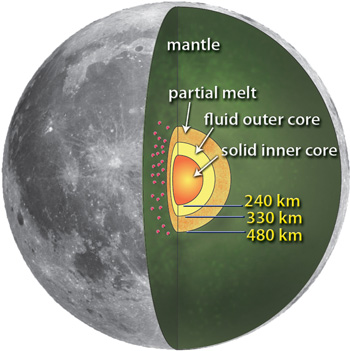The Moon’s former magnetic field
Still a huge problem for evolutionists, but not for creationists

Earth’s Moon generates no magnetic field of its own today. But in the 1970’s, Apollo astronauts brought back rock samples of the Moon’s crust that showed they formed in a magnetic field stronger than the Earth’s magnetic field today.1 This has posed a huge problem for space scientists who want to believe the solar system is billions of years old. The ‘dynamo’ theory, their as-yet-unproven explanation of planetary magnetic fields, requires a large fluid core and rapid rotation in order to even have a chance of working … and the Moon provides neither. Hence there has been much scholarly worry over how the Moon could possibly have generated a magnetic field in the past, especially a strong one.
Recently two articles2,3 appeared in the British journal Nature that tried once again to solve the problem. Though these have caused a flutter in the pop-science press, a closer examination shows that they haven’t solved the problem at all. One suggests stirring of the fluid in the Moon’s core by tidal forces when the Moon was allegedly much closer to the Earth. The other suggests that meteorite impacts stirred up the core. Given their assumed conditions, a stirring of the moon’s core fluid would be a reasonable result. But their next two assumptions are highly questionable:
(1) A self-sustaining ‘dynamo’ (electric generator) exists in the Earth’s core.
(2) The Moon’s core emulated the alleged Earth-core dynamo, despite much less favorable conditions.
Can a planetary magnetic dynamo work at all?
Various versions of the dynamo theory have been with us since 1919, when Sir Joseph Larmor suggested that motions of the fluid in the Earth’s core might act like an electric generator (or in the UK, a dynamo) to push the electric current that causes the Earth’s magnetic field.4 But then a series of ‘anti-dynamo’ mathematical theorems5 by well-known scientists showed that no simple configuration of flows and currents could generate the required field. This elimination of simple solutions forced dynamo theories to become more and more complex. They are now extremely complicated, and the resulting mathematical difficulties have prevented anyone from proving they can actually work under realistic conditions.6

Anyone who has seen the contorted winding of insulated copper wire in an electrical generator (Fig. 2) can get an idea of the theoretical problems with dynamo theories. Lacking wires with insulation, how could a uniform spherical conductor like the Earth’s core compel electric currents to travel the tortuous paths necessary? Without such guidance, the currents should follow the simplest paths (such as a circle around the rotation axis) and decay away after only thousands of years.7 Some sort of dynamo is absolutely necessary to maintain a planetary field for the alleged billions of years. So those who assume the billions of years have occurred unthinkingly assume that a dynamo has been at work, maintaining the field all that time.
To circumvent the mathematical complexity of dynamo theories, geophysicists have tried to simulate dynamo action with large computers. However, computers are not yet large enough to do a realistic simulation of the crucial small-scale turbulence in the fluid, prompting a recent reviewer to say, “Supercomputers still can’t simulate the self-[starting and maintaining] of planetary dynamos.”8 The reviewer then described a recent attempt to simulate dynamo action in the laboratory. But that lab experiment and others9 have much more complex configurations than any structure one could imagine in a planet’s core. They are actually just different kinds of artificially-constructed electric generators.
So proving that the Earth’s magnetic field comes from a ‘dynamo’ is as yet beyond the reach of theory, computer simulation, and experiment. The lack of proof after over 90 years of hard work on the theory, plus considerations of basic physical laws, such as the second law of thermodynamics, lead me to believe that a self-sustaining dynamo in the Earth’s core is impossible. So assumption (1) of the new Moon theories, that Earth has a working dynamo, is very doubtful.
Assumption (2), that conditions in the Moon could allow a dynamo to work, is even more doubtful. That is because the Moon’s core is much smaller than the Earth’s core, and the Moon rotates much slower than the Earth. If a dynamo is unlikely for the Earth, then how much more unlikely would one be for the Moon? The new articles do not address either problem (1) or problem (2). They are only concerned about how to supply mechanical power to a dynamo, not about how to make one work in the Moon.
Last, even with the above amount of ‘hand-waving’ (incomplete solutions), the two new theories only deal with Moon rocks recording weaker fields, on the order of one-tenth the Earth’s field. They fall far short of explaining rocks that recorded fields ten times stronger.10
Magnetic Moon is no problem for creation science
Creationists, on the other hand, have no problem with the Moon’s former field. Decades ago I published a theory, based on Scripture, about how God may have started the electric currents that cause planetary magnetic fields.11 The theory explains not only the strength of the Moon’s early magnetic field, but also the present fields of all large bodies in the Solar System. Recently I extended the theory to stars and galaxies, finding good agreement there also.12
Regardless of whether my theory of the origin of the field is correct, however, the absence of the Moon’s magnetic field today is easy to explain. According to simple electromagnetic theory, the decay half-life of electric currents in a core as small as the Moon’s would be only a few hundred years.13 After the biblical 6,000 years elapsed, there would be no measureable magnetic field left, which is in agreement with what we observe.
Thus the Moon’s magnetic data strongly support the biblical record of its recent creation and become a severe stumbling-block for those who want to believe in billions of years.
References and Notes
- Stephenson, A., Runcorn, K. and Collinson, D., On changes in the intensity of the ancient lunar magnetic field, Proceedings of the Sixth Lunar Science Conference, Pergamon Press, New York pp. 3049–3062, 1975. For example, accurate tests on sample number 62235, a basalt taken by Apollo 15 astronauts near the Descartes highlands, showed it had cooled down in a 1.2 Gauss magnetic field, twice as strong as the 0.6 Gauss field at the Earth’s magnetic poles today. Return to text.
- Dwyer, C.A., Stevenson, D.J. and Nimmo, F., A long-lived lunar dynamo driven by continuous mechanical stirring, Nature 479:212–214, 10 November 2011. Return to text.
- Le Bars, M., Wieczorek, M.A., Karatekin, Ö, Cébron, C. and Laneuville, M., Am impact-driven dynamo for the early Moon, Nature 479:215–218, 10 November 2011. Return to text.
- Larmor, J., Possible rotational origin of magnetic fields of Sun and Earth, Electrical Review 85:212, 1919. Return to text.
- Backus, G.E. and Chandrasekhar, S., On Cowling’s theorem on the impossibility of self-maintained axisymmetric homogenous dynamos, Proceedings of the National Academy of Sciences 42(3):105–108. March 15, 1956. The last line says, “We conclude, therefore, that no steady-state axisymmetric dynamo with constant conductivity and density can exist if [its magnetic lines of force are reasonably smooth].” Return to text.
- Brandenburg, A. and Subramanian, K., Astrophysical magnetic fields and nonlinear dynamo theory. Physics Reports 417:1–209. 2005. Online at http://citeseerx.ist.psu.edu/viewdoc/download?doi=10.1.1.160.1013&rep=rep1&type=pdf. Return to text.
- Barnes, T.G., Electromagnetics of the Earth’s field, and evaluation of electric conductivity, current, and joule heating in the Earth’s core. Creation Research Society Quarterly 9(4):222–230. March, 1973. Return to text.
- Schwarzschild, B., Turbulent liquid-sodium flow induces magnetic dipole in a laboratory analogue of the geodynamo, Physics Today 59(2):13–15, February 2006. Return to text.
- Gailis, A., Lieslausis, O. and Platacis, E., Laboratory experiments on hydromagnetic dynamos, Reviews of Modern Physics 74(4):973–989, October 2002. Return to text.
- Stephenson et al., ref. 1 above, and Fig. 2 of Dwyer et al., ref. 2 above. Note in the latter how many data points are well above even the most optimistic dashed line for the theory. 100 microTesla = 1 Gauss. Return to text.
- Humphreys, D.R., The creation of planetary magnetic fields, Creation Research Society Quarterly 21(3):140–149. December, 1984. See the section titled “The Moon” on pp. 144–145, along with its references. Archived online at www.creationresearch.org/crsq-1984-volume-21-number-3_the-creation-of-planetary-magnetic-fields. Return to text.
- Humphreys, D.R., The creation of cosmic magnetic fields; in: Snelling, A.A. (ed.), Proceedings of the Sixth International Conference on Creationism, Creation Science Fellowship, Pittsburgh, PA and Institute for Creation Research, Dallas, TX, pp. 213–230, 2008. Archived online at http://www.icr.org/i/pdf/technical/The-Creation-of-Cosmic-Magnetic-Fields.pdf. Return to text.
- Humphreys, ref. 11, p. 143, eq. (4). Return to text.



Readers’ comments
Comments are automatically closed 14 days after publication.